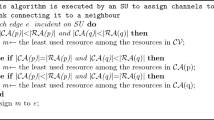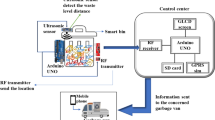Abstract
A common control channel (CCC) is required in Cognitive Radio Ad Hoc Networks (CRAHNs) for exchanging vital control messages among the cognitive radio users. However, selecting a CCC in CRAHNs is a challenging problem due to dynamic network topology, versatility of spectrum usage, and multi-hop network architecture. Existing cluster-based CCC selection algorithms are based on periodic beaconing from the cluster heads (CHs) to create and manage their clusters, which makes them more power consuming. Therefore, the battery-powered devices in CRAHNs should select a CCC in an energy-efficient way to prolong their lifetimes. In this paper, we develop an energy-efficient common control channel selection mechanism, called E 2 C 3, through creating multi-hop clusters in a distributed manner. In E 2 C 3, a node does not join a cluster actively by sensing beacons from CHs; rather, it sends an inquiry message to detect existing clusters. It resolves whether to join an existing cluster or to create a new one based on its single-hop neighborhood information. We also propose an energy-efficient passive approach of maintaining cluster membership and provide a distributed CH reassignment procedure. Our performance evaluation, carried out in NS-3, shows that our E 2 C 3 system achieves significant improvements in energy efficiency and protocol operation overhead over the state-of-the-art protocols.















Similar content being viewed by others
Notes
Cluster size of a cluster means the depth of the cluster
After cluster formation, NUM c denotes the number of nodes in the cluster as defined in Eq. 1.
References
Chen T, Zhang H, Maggio GM, Chlamtac I (2007) Topology management in CogMesh: a cluster-based Cognitive Radio Mesh Network. In: IEEE ICC, pp 6516–6521
Kim M-R, Yoo S-J (2012) Distributed coordination protocol for ad hoc cognitive radio networks. J Commun Netw 14(1):51–62
Weiss TA, Jondral FK (2004) Spectrum pooling: an innovative strategy for the enhancement of spectrum efficiency. IEEE Commun Mag 42(3):S8–14
Cabric D, Mishra SM, Willkomm D, Brodersen R, Wolisz A (2005) A cognitive radio approach for usage of virtual unlicensed spectrum. In: Proceedings of 14th IST mobile wireless communications summit 2005
Amanna A, Reed JH (2010) Survey of cognitive radio architectures. In: Proceedings of the IEEE SoutheastCon 2010 (SoutheastCon), pp 292–297
Di L, Gross J (2011) Robust clustering of ad-hoc cognitive radio networks under opportunistic spectrum access. In: IEEE international conference on communications (ICC), pp 1–6
Akyildiz IF, Lee W-Y, Vuran MC, Shantidev M (2006) NeXt generation/dynamic spectrum access/cognitive Radio Wireless Networks: a survey. Comput Netw J (Elsevier) 50:2127–2159
Mishra SM, Sahai A, Brodersen RW (2006) Cooperative sensing among cognitive radios. In: IEEE international conference on communications, ICC ’06, Vol 4, pp 1658–1663
Sun C, Zhang W, Letaief K (2007) Cooperative spectrum sensing for cognitive radios under bandwidth constraints. In: IEEE wireless communications and networking conference, WCNC 2007, pp 1–5
Ian FA, Lee W-Y, Chowdhury KR (2009) CRAHNs: Cognitive Radio Ad Hoc Networks. Ad Hoc Netw 7(5):810–836
Saifan R, Wei Y, Guan Y (2010) A framework for cooperative in-band sensing in cognitive radio network. In: Fifth IEEE Workshop on Networking Technologies for Software Defined Radio (SDR) Networks, pp 1–6
Qiang G, Lei C (2010) Distributed control channel selection algorithm for multi-hop cognitive radio networks. In: International symposium on signals systems and electronics (ISSSE), Vol 2, pp 1–4
Chen T, Zhang H, Katz MD, Zhou Z (2008) Swarm intelligence based dynamic control channel assignment in cogmesh. In: IEEE International Conference on Communications Workshops, ICC Workshops ’08, pp 123–128
Zykina AV (2004) A lexicographic optimization algorithm. Autom Remote Control 65(3):363–368
Doerr C, Grunwald D, Sicker DC (2008) Dynamic control channel management in presence of spectrum heterogeneity. In: IEEE Military Communications Conference, MILCOM 2008, pp 1–8
Lazos L, Liu S, Krunz M (2009) Spectrum opportunity-based control channel assignment in cognitive radio networks. In: 6th annual IEEE communications society conference on sensor, mesh and Ad Hoc communications and networks, SECON ’09, pp 1–9
Brandon FL (2011) A survey of common control channel design in cognitive radio networks. Phys Commun 4(1):26–39
Zhao Q, Tong L, Swami A, Chen Y (2007) Decentralized cognitive mac for opportunistic spectrum access in ad hoc networks: a POMDP framework. IEEE J Sel Areas Commun 25(3):589–600
Wu S-L, Lin C-Y, Tseng Y-C, Sheu J-L (2000) A new multi-channel mac protocol with on-demand channel assignment for multi-hop mobile ad hoc networks. In: Proceedings of international symposium on parallel architectures, algorithms and networks, I-SPAN 2000, pp 232–237
Kondareddy YR, Agrawal P (2008) Synchronized mac protocol for multi-hop cognitive radio networks. In IEEE ICC, pp 3198–3202
Xu D, Liu X (2008) Opportunistic spectrum access in cognitive radio networks: when to turn off the spectrum sensors. In: Proceedings of the 4th Annual International Conference on Wireless Internet, WICON ’08, pp 131–136, ICST, Brussels, Belgium, Belgium, ICST (Institute for Computer Sciences, Social-Informatics and Telecommunications Engineering)
Ergen M, Varaiya P (2007) Decomposition of energy consumption in ieee 802.11. In: IEEE ICC, pp 403–408
Hamdoun H, Loskot P, O’Farrell T, He J (2012) Survey and applications of standardized energy metrics to mobile networks. Ann Telecommun 67(3–4):113–123
Ahmed MHU, Razzaque A, Hong CS (2013) Dec-mac: delay- and energy-aware cooperative medium access control protocol for wireless sensor networks. Ann Telecommun 68(9–10):485–501
Razzaque A, Hong CS (2010) Analysis of energy-tax for multipath routing in wireless sensor networks. Ann Telecommun 65(1–2):117–127
Acknowledgments
We would like to pay our highest level of gratitude to the anonymous reviewer for his expert opinions and useful feedbacks, which helped a lot to enrich the quality of the paper. This work was supported by Hankuk University of Foreign Studies Research Fund of 2013.
Author information
Authors and Affiliations
Corresponding author
Rights and permissions
About this article
Cite this article
Miazi, M.N.S., Tabassum, M., Razzaque, M.A. et al. An energy-efficient common control channel selection mechanism for Cognitive Radio Ad Hoc Networks. Ann. Telecommun. 70, 11–28 (2015). https://doi.org/10.1007/s12243-014-0420-0
Received:
Accepted:
Published:
Issue Date:
DOI: https://doi.org/10.1007/s12243-014-0420-0




